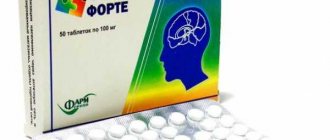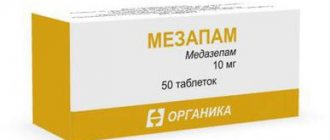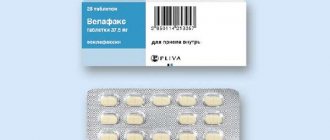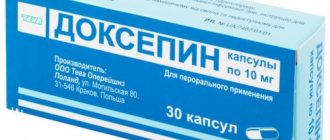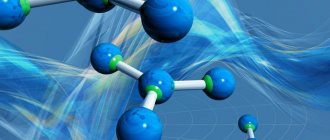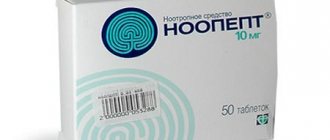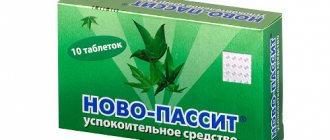The situation when a baby’s sleep is disturbed is familiar to many parents. The joy of motherhood quickly gives way to irritation, powerlessness, and fatigue. The child does not sleep well on his own and does not allow his mother to rest, who already needs to restore herself after childbirth. The problem can become so serious not only in terms of the child’s health, but in preserving a full-fledged family. The statistics are inexorable; up to 70% of marriages break up in the first year after the birth of a baby. In this article we will talk about the effectiveness of glycine in the treatment of sleep disorders in children. Let's look at how and at what age you can give it to infants. Let's talk about the opinions of doctors and reviews of mothers.
Sleep and the baby's nervous system after childbirth
The newborn needs to adapt to extrauterine life. The first month after birth is a critical period with a load on all organ systems of the baby. The digestive tract gets acquainted with food, the pulmonary circulation begins to work together with the lungs, and the nervous system receives a lot of new signals. The baby reacts to any discomfort as best he can - he wakes up and cries. The task of parents and doctors is to help the baby overcome the crisis of the newborn period. A baby's sleep is very different from an adult's:
- Adults fall asleep and immediately plunge into a deep sleep phase. Infants in the first months of life fall asleep in the shallow phase, when they can be very easily awakened. They reach deep sleep in about half an hour. A tired mother can fall into this trap when she starts rocking her baby in the hope that he will fall asleep faster. Without waiting for slow sleep, she puts him in his crib. The baby wakes up and cries. This can be repeated until the mother develops neurosis. Here you just need to wait until the newborn’s body relaxes, the fists unclench, the legs hang, and the grimace on the face goes away. This is the slow-wave sleep phase. Now feel free to put your baby in the crib.
- The duration of an adult's sleep cycle is about 2 hours. There can be 5-6 such cycles per night. In a baby, they are almost half as long, and during the transition from one to another, he can wake up. If your baby wakes up after a deep sleep, pat him on the back, hold him to your chest, or sing a lullaby. Over time, he will easily move through the phases without help.
- Newborns have more total surface sleep time than adults. Therefore, they are easy to wake up. This is nature's wise decision to prevent sudden infant death.
- After six months, the baby can already sleep through the night and not wake up. If a child wakes up at night after a year, then the reason is most likely not in sleep patterns, but in external factors (lack of mother, nightmares, illness).
When may you need medication to treat your sleep disorder?
Not many medications are approved for use during the breast period. There can also be many reasons for sleep disorders in infants. Only 10% occurs due to various diseases. The rest is associated with incorrect parental tactics, poor sleep hygiene and is benign and transient.
Attention! The neurologist decides whether or not to take medications to correct sleep disorders.
Most often, treatment is prescribed for moderate to severe perinatal damage to the central nervous system. The perinatal period is the period “around childbirth” and includes the last stages of pregnancy, childbirth and the first week after birth. The brain of the fetus/newborn at this time is very sensitive to oxygen starvation (intrauterine hypoxia or hypoxia during childbirth). Intrauterine infections, trauma during childbirth, intoxication and maternal illness have a damaging effect on it. The consequences of CNS PP can be different, from complete recovery to severe cerebral palsy. Sleep disorder is a common symptom of babies who have suffered perinatal damage to the central nervous system.
How does glycine help against insomnia?
Glycine or aminoacetic acid is a non-essential amino acid that is found in many foods (meat, fish, cheese, gelatin, etc.) and is also synthesized in our body.
In the central nervous system, glycine plays the role of an inhibitory transmitter. There are receptors for it in the brain and spinal cord. By contacting them, it has an “inhibitory” effect on nerve cells, regulating the processes of excitation/inhibition. Its action is not limited to this:
- Glycine as a neuroprotector. By participating in metabolic processes inside the nerve cell, it helps it more easily tolerate the resulting oxygen starvation.
- Antioxidant effect - glycine is part of the structure of glutathione, the first defender against free radicals in our body.
- Performs a detoxification function - it forms complexes with toxic substances that are safely eliminated.
- Improves sleep, reduces aggression and emotional stress.
- Promotes easier social adaptation (to school, kindergarten, in a new team).
- Shown to be effective in the complex treatment of mental retardation, neurotic and speech disorders, and epilepsy.
Basic properties of glycine
Glycine belongs to the group of 20 simplest amino acids. It is a non-essential amino acid because it is synthesized inside the human body. Actively participates in the formation of almost all proteins and the transmission of nerve impulses.
The range of application of the drug is quite wide. It regulates metabolism and activates protective processes in the nervous system. Helps cope with emotional and mental stress. Has antioxidant and antitoxic effects.
Important ! You should not give medications to a child without a doctor’s prescription! Glycine, if indicated, should be prescribed by a pediatric neurologist.
Instructions for use: what points you should pay attention to
Nowadays there are many drugs containing glycine. Not everything can be given to children! Some of them add other components (for example, B vitamins), then they already belong to dietary supplements. We will look at classic glycine produced by BIOTICS. This is a neurotropic and metabolic drug according to the pharmacological group.
- Available in packages of 50 and 100 sublingual tablets at a dose of 100 mg. There is Glycine-Bio () with a smaller “children’s” dose - 50 mg per tablet.
- In addition to the main substance, the tablet contains auxiliary substances: magnesium stearate (prevents clumping, increasing the effectiveness of the tablet) and water-soluble methylcellulose (thickener, stabilizer). They are needed for better dissolution of the tablet. There is no point in swallowing the drug, just dissolve it under the tongue or behind the cheek.
- Available without a prescription.
- It is quickly metabolized by liver enzymes, excreted and does not accumulate in tissues.
- Allowed for infancy, pregnant and lactating women. Passes through breast milk.
- Side effects include the possible development of an allergic reaction.
Glycine for babies
Infant age is considered to be up to 1 year. From one to three years is an early age. The instructions for use do not specify how to give the drug to an infant. There the dose is indicated for children under 3 years of age, which also includes the period of infancy. The minimum age at which a doctor can prescribe glycine is 1 month. For infants up to 3 months of age, the recommended dose according to the instructions is high (50 mg 2-3 times a day).
For a baby from 1 to 3 months old, the doctor may prescribe glycine according to the following regimen:
- 25 mg 2-3 times a day (this is ¼ of a 100 mg tablet);
- If the mother is breastfeeding, the drug can be prescribed to her in an adult dose, and the baby will receive it through breast milk.
The average duration of treatment is 2 weeks, but can be extended to a month. From three months to the end of early childhood, glycine is usually prescribed as indicated in the instructions - 50 mg 2-3 times a day. It reduces anxiety, tearfulness, and normalizes sleep.
Parents' reviews of Glycine
“Since birth, my son could not sleep all night. I woke up every 2-3 hours, although I didn’t want to eat, and the diaper was dry. Like most other mothers whose children faced similar problems, I decided to see a doctor. We were prescribed herbal teas and longer walks during the day. All this did not bring much results. By the end of the third month after giving birth, I felt that I would soon begin to suffer from various mental disorders due to fatigue.
As always, the Internet came to the rescue: I read positive reviews about Glycine for newborns and decided that the pills would definitely not harm my three-month-old baby. I simply crushed the tablets into a fine powder and added them to the milk formula (I don’t breastfeed).
To be honest, I myself started taking 4 tablets a day, since constant stress caused me insomnia. Even when there is complete silence in the apartment, I do not fall asleep.
The result appeared after 2 weeks of use: my son began to wake up only 1-2 times a night, and I myself finally began to feel some relaxation.”
Kuklina Inessa Petrovna, 32 years old
“Before giving Glycine to a child (age 1 year), I read reviews and consulted with pediatricians. Several doctors told me that the supplement would definitely not harm the baby, but would help him sleep better. I had already bought the coveted package when I encountered real rejection from my mother. She insisted that any supplements could adversely affect her son’s health in older age.
As a result, the child felt negative about the pills and simply refused to take them! I made a mistake and literally forced me to take the supplement. My son was vomiting, and I actually had to throw Glycine out.”
Astakhova Irina Fedorovna, 29 years old
“My son was born with acute encephalopathy. Doctors put notes on the card about hypoxic-ischemic injury and intracranial hemorrhage. Naturally, I hoped for a miracle and began to look for a “magic” pill that would cure my baby.
Judging by the reviews, Glycine could be such a medicine. But the neurologist who guided us argued that such supplements should not be given to infants up to 6 months, because the digestive system is not yet ready for them.
I voluntarily began adding Glycine powder to my expressed milk after my son was 4 months old. As a result, I noticed a positive trend in my son’s recovery, without any side effects!”
Eldarova Mira Sergeevna, 32 years old
How to give glycine to a baby
There may be several ways. Whatever option you use, you need to try to ensure that the maximum amount of medicine is absorbed into the oral cavity. You can:
- Grind the tablet into powder, moisten it with a little boiled water and apply it to the pacifier (or pacifier). During sucking, the drug will finally dissolve with the baby’s saliva. As an alternative, apply the moistened powder from the tablet onto a clean finger and rub it behind the cheek.
- Dissolve the required dose of the tablet in water (usually 3-5 ml) and pour it into the baby’s mouth using a spoon, through a pacifier, pipette or using a measuring syringe. It is better if you do this by the cheek, the liquid that gets on the tongue will be immediately swallowed.
- You can use a pacifier for medicine.
- Some doctors advise pouring the prepared solution with glycine into the formula (or expressed milk) and giving it to the baby. However, with this method, everything ends up in the gastrointestinal tract.
Children from 2 years old can already dissolve a tablet in their mouth like adults. This should be supervised by parents to prevent it from entering the respiratory tract.
Doctors' opinion
Glycine is widely used in pediatric practice. It is prescribed by pediatricians, neurologists, child psychiatrists not only for children experiencing sleep problems, but in the complex treatment of hyperactivity syndrome (ADHD), vegetative-vascular dystonia, autism, etc. It is well tolerated, and side effects are extremely rare. In infants, in isolated cases, a paradoxical reaction was observed in the form of increased processes of nervous excitability. In general, the attitude of doctors towards the drug is positive or neutral. It is impossible not to mention the opinion of Komarovsky, a doctor whom many mothers trust. When asked about the advisability of a child taking glycine, he answered: “Why give it to your child - I have no idea, I think just in case.” In the European Union countries, the drug is not used for infants; there is no reliable evidence base for its effectiveness.
Negative reactions to the drug
Parents must know and take into account that their baby may have negative reactions when taking this drug. For example, instead of calming down, the child becomes overly excited, capricious, and restless. If negative reactions occur during the use of glycine for newborns, you must immediately inform your doctor. Increased nervousness and poor sleep should be a reason to discontinue the drug. After all, it is quite possible that this substance is not suitable for the child, and he will need to choose something similar, but tolerable.
Glycine for infants with sleep disorders: reviews from mothers
Mothers who gave the drug to their babies were divided into three camps:
- The first consider it inappropriate to “poison children” with any chemicals. They started giving glycine as prescribed by the doctor, but didn’t see the effect right away and stopped it at the beginning of the course. This is a very small group of mothers.
- The latter did not see the effect after completing the course; the baby’s sleep did not improve, “what they gave, what they didn’t.” There are many such reviews.
- The third group of mothers noted a good effect after a course of glycine. They noted an improvement in falling asleep and sleep duration, hypertension went away faster, and the child became less whiny. The percentage of positive reviews is approximately equal to neutral.
If your baby is prescribed glycine, do not be afraid of this medicine. On the one hand, there is no evidence base for its effectiveness. On the other hand, the drug has been tested by time. The goal of treatment is not only the quality of your baby’s sleep, but also your strength. The mother must have a resource to provide care and development for the baby. Every baby needs a good night's sleep and an affectionate mother!
Author: Yulia Tamanskaya especially for the website Matrasium.ru
Source
Author Irina Dobronravova Reading time 6 min.
Glycine for infants can be used for the treatment and prevention of diseases of the nervous system or brain. But first you should consult a pediatrician and find out whether the child’s body needs to take amino acids.
Now Foods, Glycine, Pure Powder, 454 g
★★★★☆
from 1,136 ₽
Benefits of glycine for newborns
Before starting use, you need to find out whether glycine can be given to a newborn. Aminoacetic acid is a nootropic; it normalizes metabolism in the brain, improves its functioning, and also:
- stabilizes the condition of children with neurological disorders;
- reduces the severity of disorders in ischemic brain damage;
- inhibits the excitation of the nervous system, reduces the formation of glutamic acid in neurons, increases the production of GABA;
- normalizes metabolism, as well as the functioning of the nervous system;
- improves the psycho-emotional state and mood of the newborn.
The drug calms, reduces anxiety and fear in the child, facilitates adaptation to the environment, and relieves stress.
Attention! Glycine is prescribed to newborns to reduce the toxic effects of drugs, as it has antitoxic properties.
Why is Glycine prescribed to newborns: instructions for use
Glycine is defined as aminoacetic acid, which is part of proteins and protein compounds. This is a nonessential amino acid, that is, one that is synthesized in the human body from other similar elements. Glycine is found in foods of plant and animal origin, such as beef, oatmeal, nuts, sunflower seeds, pumpkin seeds, etc.
Entering the body with food, this amino acid enters the digestive system and then takes part in the synthesis of proteins. If the body receives glycine in tablet form, it immediately enters the blood and moves to the brain, where under its influence chemical processes occur that reduce the effect of excitation.
It is used in medicine as a nootropic agent, that is, one that can stimulate mental activity, improve memory, and increase the brain’s resistance to heavy loads or harmful influences. This amino acid is the active ingredient of many pharmaceuticals. Manufacturers of such products declare that glycine preparations have a calming effect, have a mild antidepressant and tranquilizer effect (relieve anxiety), neutralize feelings of fear and emotional stress, improve memory and stimulate brain activity, increasing its performance.
Due to these properties, glycine is often prescribed for:
- overcoming psycho-emotional stress, neutralizing aggressiveness and conflict, facilitating social adaptation;
- combating sleep disorders and facilitating the process of falling asleep;
- mood improvement;
- reducing the manifestations of vegetative-vascular disorders;
- activating mental activity, improving memory;
- reducing the severity of cerebral disorders in certain types of strokes and brain injuries.
Pediatricians and pediatric neurologists often prescribe glycine preparations even to the youngest children. For what purpose are they doing this?
This drug is prescribed to newborns (children in the first month of life) only for serious indications, even though it is of natural origin. Glycine is usually prescribed if:
- the child was exposed to hypoxia during pregnancy or childbirth;
- during birth the nervous system or its parts were damaged;
- the child has severe encephalopathy;
- increased muscle tone.
For children in the first year of life, this remedy is prescribed to normalize sleep, for hyperactivity or nervous system disorders.
Timely use of this remedy helps to correct the functioning of the nervous system, prevent pathologies and delays in the mental development of children. But it should not be given to a child without permission or on the recommendation of friends. Only a doctor can determine whether a child needs treatment, if so, how to carry it out and what medications to use.
Indications for use
Glycine is indicated for infants in the following cases:
- traumatic brain injury received at birth;
- oxygen starvation of the brain (hypoxia);
- neurological disorders, namely perinatal encephalopathy, cerebral palsy, etc.;
- ischemic brain damage, stroke;
- movement disorder caused by increased or decreased muscle tone;
- tremor of the chin or limbs (more often observed in children older than 3 months);
- insomnia;
- increased excitability, psycho-emotional stress;
- mental retardation, impaired concentration.
The drug improves mood, relieves headaches, tremors of the limbs, and normalizes muscle tone. It can also be used to prevent many nervous disorders.
Attention! The amino acid does not act immediately; the effect of taking it appears after the second week.
Is it possible to give food sources to a baby?
The amino acid is produced by the body and comes from outside with food. If the baby does not have neurological disorders, then it is not recommended to give it to the baby. It is enough for him to receive aminoacetic acid through breast milk, the main thing is that the mother consumes foods high in glycine. This substance is found in legumes, eggs, seafood, meat, cereals, vegetables and fruits.
Table - Food sources of amino acids
| Products | Amount, mg/100 g |
| Parsley | 1,8 |
| Veal | By 1.6 |
| Beef liver | |
| Rabbit meat | |
| Turkey liver | 1,5 |
| Chicken breast (no skin) | 1,4 |
| Duck | 1,3 |
| Baked mackerel, herring or carp | By 1.1 |
| Peas | |
| Buckwheat | 0,9 |
Under stress, the body requires additional amounts of aminoacetic acid, which creates the need to take supplements.
How to use the drug
The tablet must be dissolved under the tongue, but this method is not suitable for an infant. Glycine is given to newborns in the form of a powder or solution. There are such methods of application:
- Applying the drug to the pacifier. The tablet must be crushed, then the pacifier should be rolled in the resulting powder and given to the newborn. The medicine is sweet, so the baby will suck the pacifier with pleasure. Instead of a pacifier, you can also use your finger - also roll it in powder and coat the inside of the baby's cheek with it.
- Mixing the drug with water, infant formula or breast milk. Dilute the powder with a few drops of liquid and give the baby to drink from a spoon.
How to give the drug to newborns?
The instructions for glycine contain a detailed description of the properties of the drug, its method of use and dosage. As a rule, small children enjoy swallowing these pleasant-tasting little tablets. In this regard, it is enough to put the tablet under the child’s tongue.
As for newborn babies, then, of course, this method of administration is not suitable for them. The following methods are considered the best option for taking glycine for infants:
- in the form of an aqueous solution, when the required dosage of the tablet is ground to a powder and diluted with a certain amount of water, so that the solution can later be dripped into the child’s mouth from a pipette or given from a spoon;
- A pacifier is dipped into a tablet crushed to powder and given to the baby;
- The crushed tablet can be added to formula, water, or other bottled drink.
Additionally > What actions to take in case of an umbilical hernia in a baby
The effectiveness of the drug may vary between children. For some it helps almost from the first days of taking it, but for others it is a completely useless medicine. The speed of recovery and the severity of the effect of the medicine depends on the individual characteristics of the child’s body, the severity of the disease and some other factors. In this regard, parents, together with the attending physician who prescribed glycine, should carefully monitor its effect on the child’s body, its effectiveness, and make an individual decision regarding the advisability of its further use.
Reading...
What is pemphigus and why is it dangerous for an infant?
Rate this article
Loading…
- Related Posts
- What is dacryocystitis and how should it be treated?
- Types of dermatitis in infants and treatment methods
- Hypoxia in newborns: symptoms, consequences and treatment
Dosage and regimen
The amino acid must be taken in courses. Only in this case does it produce a therapeutic effect. Her baby is prescribed no more than 0.1 g per day. This is the maximum norm that cannot be exceeded.
The dosage for an infant should be selected by a pediatrician depending on the age of the infant, indications for use and concomitant diseases.
Children under 1 year of age are prescribed glycine 2-3 times a day, 25 or 50 mg (1/4 or 1/2 tablet). The duration of the course is 1 month (no more).
Attention! The daily norm when breastfeeding is 300 mg.
To improve sleep, it is enough to give a one-month-old baby the medicine at night, 30 minutes before resting. Dose – 25 mg.
Glycine for children: reviews – Komarovsky
» Miscellaneous » Glycine for children: reviews – Komarovsky
More than one generation of parents and children is familiar with glycine. The drug has long been considered an indispensable remedy in the first aid kit of families with school-age children.
Glycine stimulates the renewal of brain cells, improves concentration and memory, and has a beneficial effect on the brain.
Doctors still prescribe glycine to children: reviews (Komarovsky has nothing against the drug) from specialists speak in favor of using this drug.
What is the secret to the success of glycine, which has been used in pediatrics for many years? Komarovsky believes that the main advantage of the drug is the absence of harm. Whether glycine should be prescribed to children can only be decided by the attending physician; according to Komarovsky, the drug will not cause harm to children's health, although its therapeutic effect is questionable.
According to the Kyiv pediatrician, it has still not been possible to prove the effectiveness of glycine using medical methods, but this does not detract from the advantages of the drug: over its long history, glycine has managed to establish itself as a reliable and safe means for improving brain activity.
How does glycine work for children?
Glycine belongs to the group of neurometabolic stimulants aimed at improving the higher integrative functions of the brain. Komarovsky believes that there is no particular point in prescribing glycine to children, but reviews from other doctors indicate the high effectiveness of the drug.
What is the real power of glycine? As Komarovsky says, the product calms parents more than it affects children.
But what do other doctors say? Pediatricians recommend the drug for normalizing mental activity, relieving tension during periods of intense mental stress, responsible performances and events that require increased attention.
Despite the high safety of the drug, its excessive use can lead to serious disorders, in particular brain atrophy. True, no severe cases were recorded after consuming glycine.
Glycine helps:
- reduce aggressiveness,
- improve mood,
- reduce the influence of stress factors,
- increase mental performance,
- get rid of deviant behavior.
The drug has no contraindications except for individual intolerance.
Children under 3 years of age are prescribed half a tablet of the drug 2-3 times a day. The duration of therapy should not exceed two weeks. Children over 3 years old are prescribed 1 tablet three times a day. The duration of therapy can be increased to 1 month.
Glycine may be recommended for sleep disorders. It is enough to take half a tablet before bed for a week. The drug has proven its effectiveness as a means of reducing psycho-emotional stress and improving brain function in the presence of organic lesions of the central nervous system and peripheral nervous system.
Side effects, allergies
Glycine for newborns is one of the safest substances used for neurological diseases. However, even this can cause adverse reactions.
The amino acid is poorly tolerated when doses are exceeded, the dosage regimen is violated, or when combined with sleeping pills and tranquilizers. In children, after taking a drug based on it, the following adverse reactions may occur:
- increased psycho-emotional excitability, anxiety, restlessness;
- decreased blood pressure;
- headache, dizziness;
- worsening sleep;
- mental disorders;
- fainting;
- allergies in the form of itching, skin rash, red spots, swelling, hoarseness, cough.
The first time after starting treatment, it is necessary to monitor the reaction of the baby’s body. If side effects occur, you should stop using the drug and go to the hospital.
The benefits of aminoacetic acid are described in the video:
Side effects and contraindications
The instructions for use state that the drug has no clear contraindications for use. The body easily absorbs the amino acid and removes it just as quickly without accumulating it. Which contributes to minimal side reactions. However, we should not forget about individual intolerance, which occurs in extremely rare cases (according to reviews from mothers about the dosage of “Glycine” for children). Then allergies appear or anxiety increases. To fix such signs, the drug is discontinued and another one is selected together with a neurologist. Glycine is considered safe from birth. This drug is often prescribed to pregnant women while breastfeeding. But you need to keep in mind that it works differently when taking antidepressants. The combined use of two groups of medications is selected specifically.
Reviews about the application
Leave feedback about aminoacetic acid. Write what pros and cons you found:
| Leave your review | |
| 1 2 3 4 5 | |
| Check the box here to confirm that you are human. | |
| Send Cancel | |
Glycine for babies
Average rating:
Number of reviews: 0
Based on the reviews, the following advantages were identified:
- glycine for infants calms the child’s nervous system;
- normalizes sleep.
But not all buyers confirm the effectiveness of the drug. Some mothers write in reviews that the amino acid does not work at all.
The opinions of pediatricians also vary. Some consider the drug to be a good sedative, which is suitable for infants, while others consider it to be an ineffective remedy.
Well-known pediatrician Evgeny Olegovich Komarovsky in the country considers glycine useless for children in the first year of life. But he also claims that the amino acid does not eliminate neurological disorders, but is effective only in the treatment of alcoholism and psychiatric diseases.
Properties and functions of glycine
Glycine is an amino acid that is considered almost native to the human body, including children’s. It is integrated into the metabolic process and improves it on several levels. As a result of optimizing metabolism, the activity of the nervous system is debugged, which helps eliminate neurological problems.
Regardless of whether glycine is used for infants or adult children, you can expect to obtain the following results:
- The processes of inhibition and excitation are normalized, and the necessary balance is achieved.
Advice: Today, drugs claiming to be glycine analogues are appearing on the pharmacological market. If, when treating adults, the differences in the compositions turn out to be insignificant, then it is better not to use them to correct the condition and behavior of children, especially under the age of one year. The consequences can be very unpredictable, and the expected therapeutic effect is minimal.
- Mental performance increases.
- Signs of increased irritability, apathy and depression disappear.
- Sleep patterns and quality are normalized.
- The manifestations of vegetative-vascular dystonia are smoothed out.
In addition, glycine can be given to newborns who are at high risk of nervous disorders due to exposure to negative factors on the fetus during pregnancy.

